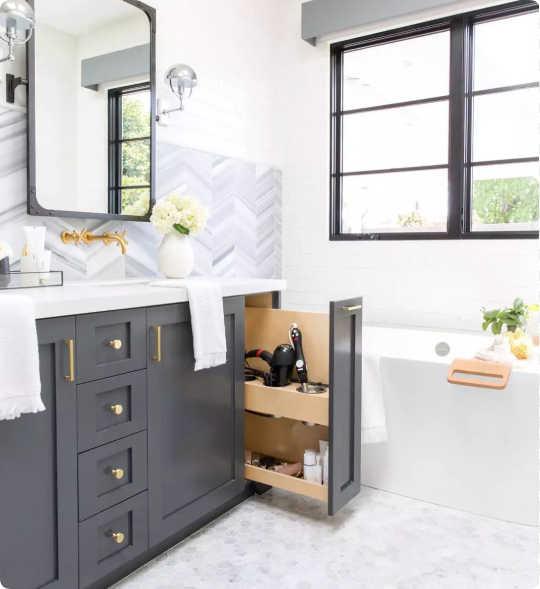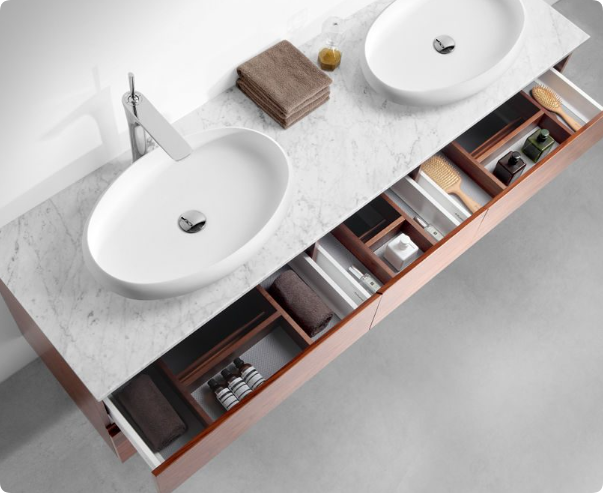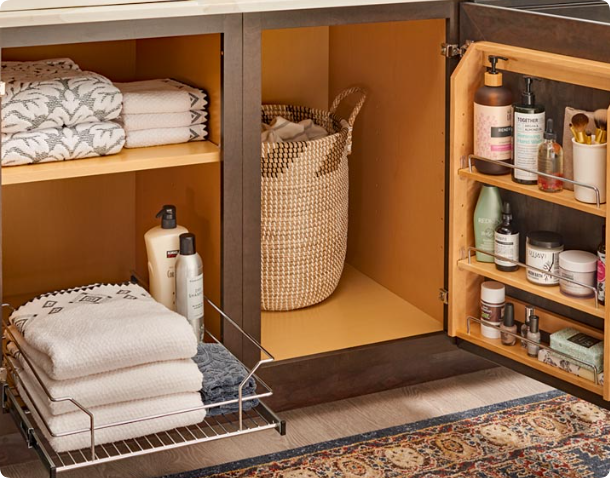When it comes to bathroom renovations or new constructions, one of the most common questions homeowners and designers ask is: “Are bathroom vanities standard?” It’s an important question because bathroom vanities not only serve as functional storage but also contribute significantly to the overall aesthetic of the bathroom. However, the answer is not as simple as “yes” or “no.” There are many factors that determine the “standard” dimensions and features of a bathroom vanity, and these can vary based on design trends, the size of the bathroom, and the specific needs of the homeowner.
This article will explore the concept of standard bathroom vanities in detail. We’ll examine the various factors that influence vanity sizes and styles, discuss the pros and cons of different vanity configurations, and guide you through selecting the right vanity for your bathroom space. We’ll also use a comparative table to highlight key differences between various vanity sizes and types to help you make an informed decision.
What Are Bathroom Vanities?
A bathroom vanity typically consists of a sink or multiple sinks, storage space (often in the form of cabinets or drawers), and a countertop. It’s an essential part of the bathroom’s layout, providing not only a place to store toiletries, towels, and cleaning supplies but also a functional area for personal grooming. Depending on the design, vanities can be freestanding, wall-mounted, or even integrated into other bathroom fixtures.
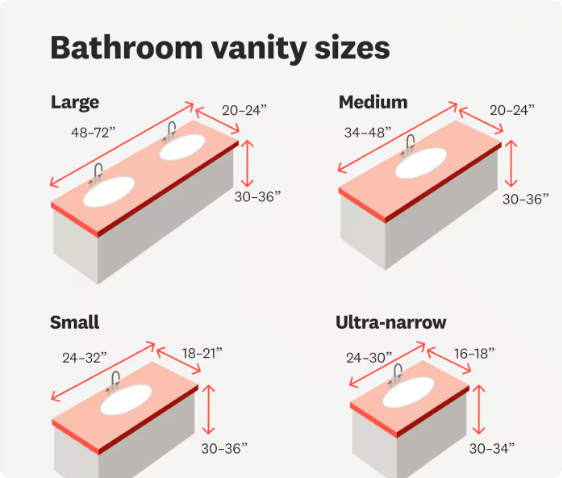
Standard Bathroom Vanity Sizes
When people refer to “standard bathroom vanities,” they are typically talking about common dimensions for vanities designed to fit typical bathrooms. There is no single, universal size, but most vanities tend to fall within a range of standard measurements.
1. Single-Sink Vanities:
For smaller bathrooms, a single-sink vanity is the most common choice. These vanities typically range from 24 to 36 inches in width, with a depth of 18 to 24 inches. The height generally ranges from 30 to 34 inches. This size works well for powder rooms or smaller master bathrooms.
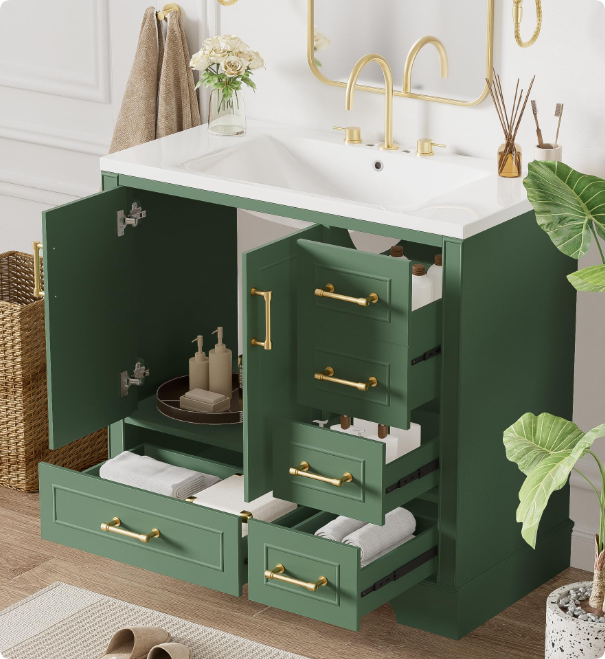
2. Double-Sink Vanities:
Double-sink vanities are ideal for larger bathrooms or shared spaces. These vanities are typically 60 to 72 inches in width and offer the convenience of separate sinks for two users. The depth and height are usually similar to those of a single-sink vanity.
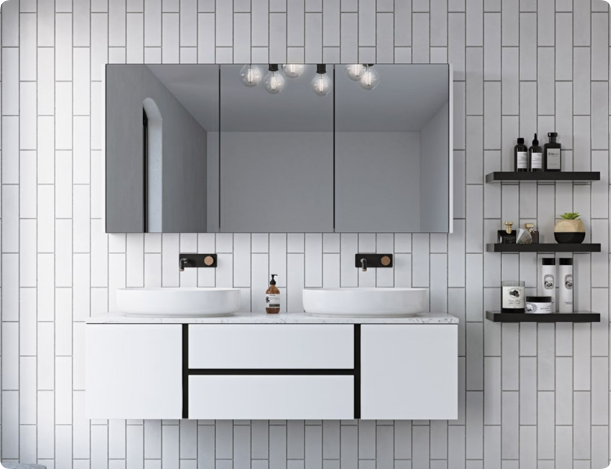
3. Wall-Mounted Vanities:
Wall-mounted vanities (or floating vanities) are mounted directly to the wall, creating the illusion of more space by exposing the floor beneath. These can vary widely in size, but the most common width range is 30 to 48 inches, with depths of 18 to 22 inches and a height of 30 to 36 inches.
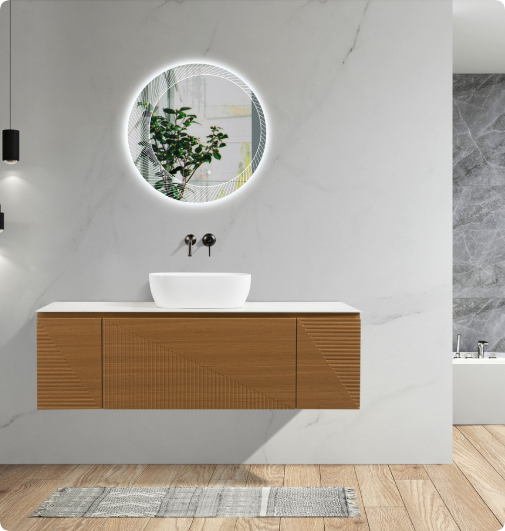
4. Custom Vanities:
For unique or oversized bathrooms, custom vanities can be made to fit specific measurements and needs. Custom vanities are designed according to the available space, which means they can be built to virtually any size.
Are There “Standard” Features?
In addition to size, several features are considered “standard” in most bathroom vanities, though these features can vary depending on the style, price point, and manufacturer:
1. Storage Options:
Most bathroom vanities include some form of storage, such as cabinets, drawers, or open shelving. However, the amount and type of storage will vary. Single-sink vanities often feature a large cabinet with one or two doors, while double-sink vanities might have multiple drawers and cabinets to maximize storage.
2. Countertop Material:
Standard vanity countertops are often made of materials like laminate, granite, marble, or quartz. While laminate is the most affordable, granite and quartz are the most durable and visually appealing.
3. Sink Type:
The most common types of sinks found in bathroom vanities include undermount sinks, vessel sinks, and drop-in sinks. Undermount sinks are popular for their sleek, modern look, while vessel sinks offer a more dramatic, stylish appearance.
4. Finish and Style:
Vanities come in a range of finishes, from traditional wood finishes like oak or maple to modern painted finishes in colors like white, gray, or black. Styles range from classic to contemporary, with options including shaker-style, rustic, and even industrial designs.
What Factors Affect Vanity Size and Fit?
Several factors influence the size and style of a bathroom vanity, making the concept of “standard” highly subjective. Here’s a look at the most important considerations:
1. Bathroom Size
The size of your bathroom plays a crucial role in determining the vanity size. Smaller bathrooms, like powder rooms or half baths, usually require a compact vanity. Larger bathrooms, especially those with space for a double vanity or a separate shower and bathtub, can accommodate larger vanities.
2. Functionality
Consider how many people will use the bathroom and how much storage you need. A single-sink vanity may suffice for a guest bathroom, while a double-sink vanity or one with extra drawers may be better suited for a family bathroom or master bath.
3. Design Trends
Bathroom design trends change over time, and vanities are no exception. For example, wall-mounted vanities and floating vanities have gained popularity in recent years for their minimalist appeal and ability to make a bathroom appear larger.
4. Accessibility
In modern bathroom design, accessibility is key. Standard vanities should be built with accessibility in mind, with features like adjustable shelves, low-threshold sinks, and easy-to-reach storage. This is especially important for people with disabilities or mobility challenges.
5. Budget
Finally, your budget will also influence your choice of vanity. While “standard” vanities are often less expensive, custom options or high-end materials (like marble countertops) can drive the cost significantly higher.
Comparing Different Vanity Sizes and Styles
To help you visualize the differences in vanity sizes and styles, here’s a comparison table of common vanity options:
| Vanity Type | Width | Depth | Height | Storage Options | Best For |
|---|---|---|---|---|---|
| Single-Sink Vanity | 24-36 inches | 18-24 inches | 30-34 inches | Cabinet with one or two doors | Small to medium bathrooms |
| Double-Sink Vanity | 60-72 inches | 18-24 inches | 30-34 inches | Multiple drawers and cabinets | Shared bathrooms, larger bathrooms |
| Wall-Mounted Vanity | 30-48 inches | 18-22 inches | 30-36 inches | Minimal storage (open shelving) | Modern, minimalist spaces |
| Custom Vanity | Custom (varies) | Custom (varies) | Custom (varies) | Tailored storage solutions | Unique or oversized bathrooms |
How to Choose the Right Vanity for Your Bathroom
When selecting a bathroom vanity, consider the following key factors:
- Space Availability: Measure your bathroom’s dimensions to ensure the vanity will fit without crowding the space. Remember to leave room for other fixtures, like the toilet and shower.
- Functionality Needs: Determine how many people will use the bathroom and how much storage is necessary. Double-sink vanities are perfect for shared bathrooms, while single-sink vanities may be enough for small guest bathrooms.
- Aesthetic Preferences: Choose a vanity that complements the style of your bathroom. Whether you prefer a traditional wood finish or a sleek, modern floating vanity, make sure the design aligns with your vision for the space.
- Budget: Be realistic about your budget. A standard vanity can be affordable, but if you’re opting for high-end materials or a custom design, the price will increase.
- Durability and Materials: Choose durable materials that can withstand the moisture and wear-and-tear typical of a bathroom. Granite, quartz, and solid wood are excellent options for durability.
Conclusion
While there are some standard dimensions and features for bathroom vanities, the ideal vanity for your space will depend on a variety of factors, including your bathroom’s size, functionality needs, and personal preferences. Whether you opt for a single-sink or double-sink vanity, wall-mounted or custom-built, choosing the right vanity will enhance the beauty and functionality of your bathroom. Remember to measure carefully, consider storage needs, and stay within your budget to ensure that your new vanity fits perfectly into your space.
By understanding the different types of vanities, their sizes, and how to choose one that fits your needs, you can make a well-informed decision that will bring both style and practicality to your bathroom.
Want to expand your sanitary business? Get in touch with www.danubetoilet.com today for consultation and bulk ordering solutions.

